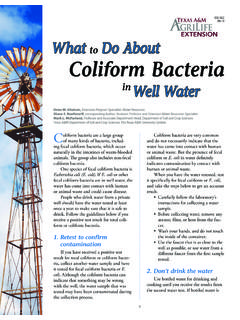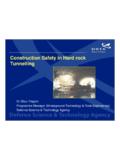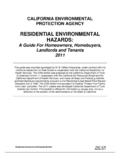Transcription of Drinking Water Problems:Radionuclides - TWON
1 Radionuclides are types of atoms that areradioactive. The most common radionu-clides in Drinking Water are radium, radonand uranium. Most of the radionuclides in Drinking Water occur nat-urally at very low levels and are not considered a pub-lic health concern. However, radionuclides can also bedischarged into Drinking Water from human activity,such as from active nuclear power plants or other facil-ities that make or use radioactive who are exposed to relatively high levels ofradionuclides in Drinking Water for long periods maydevelop serious health problems, such as cancer, ane-mia, osteoporosis, cataracts, bone growths, kidneydisease, liver disease and impaired immune are the Sources of Radionuclides in Water ?Radiation comes from outer space, from the groundand even from within our own bodies. Radiation is allaround us and has been present since the birth of thisplanet. Most of the radionuclides present in Drinking Water arefrom natural sources. Naturally occurring radionuclidesare created in the upper atmosphere and are found inthe Earth s crust.
2 They are found in certain types ofrocks that contain trace amounts of the radioactive iso-topes (forms) of uranium, thorium and/or actinium. Asthese rocks weather, the resulting clays and other mate-rials may transmit radionuclides into Drinking levels of radionuclides tend to be found moreDrinking Water Problems:RadionuclidesBruce J. Lesikar, Professor and Extension Agricultural Engineer, Texas Cooperative Extension,Rebecca H. Melton, Extension Assistant,Michael F. Hare, Senior Natural Resources Specialist Pesticide Programs Division,Texas Department of Agriculture,Janie Hopkins, Manager Groundwater Monitoring Section, Texas Water Development Board,Monty C. Dozier, Assistant Professor and Extension Specialist,The Texas A&M University SystemB-61927-06'often in groundwater, such as from wells, than in sur-face Water , such as lakes and streams. Many human-made devices and processes result inradioactivity. The list includes, but is not limited to,color television, medical instruments (x-rays andchemotherapy), coal/lignite power plants, industrialprocesses and cigarette smoking.
3 Radionuclides inwater are more likely to be from naturally occurringsources than manmade time, radionuclides decay. As they decay, theyproduce daughter products that are shorter lived,and more radioactive. Of particular concern arenaturally occurring uranium and radium, which canaccumulate to harmful levels in Drinking radionuclides decay, they emit radioactive parti-cles such as alpha particles, beta particles andgamma rays. Each type of particle produces differenteffects on particlesare the least penetrating type ofradioactive particles; they can be stopped by a sheetof paper or the skin. However, they are still harmfulif inhaled or ingested, because then they come intocontact with internal organs. Even though they arethe least penetrating, alpha particles cause moredamage per unit volume than do beta particles orgamma rays. Beta particlesand gamma raysdeposit their ener-gy over longer distances. Beta particles can bestopped by a piece of wood or a thin sheet of metalsuch as aluminum foil.
4 Gamma rays, like x-rays, canpass through the human body and are best shieldedby dense materials such as lead or thick no higher than 4,000 pCi/L. Becauseabout 1/10,000th of radon in Water transfers toair, this would contribute about pCi/L ofradon to the air in a home. This level will bepermitted if the state also takes action toreduce radon levels in indoor air by develop-ing EPA-approved, enhanced state radonindoor air programs (called MultimediaMitigation Programs). This is important,because most of the radon you breathe comesfrom the soil under the house. This optiongives states the flexibility to focus on thegreatest problems, encouraging the public tofix indoor air problems and to build homesthat keep radon from entering. A second option is provided for states thatchoose not to develop enhanced indoor airprograms. Community Water systems in thosestates would be required to reduce radon lev-els in Drinking Water to 300 pCi/L. Thisamount of radon in Water contributes pCi/L of radon to the air in your home.
5 Even if a state does not develop an enhancedindoor air program, Water systems may choose todevelop their own local indoor radon option would require them to meet a radonstandard for Drinking Water of 4,000 pCi/L. Thisoption would enable the reduction of overall risksfrom exposure to radon from both air and Water . Where have Wells with High Levels of Radioactivitybeen Found in Texas?To monitor the quality of our Water , the TexasWater Development Board (TWDB) collects ground- Water samples in the state through its GroundwaterQuality Sampling Program. From 1988 to 2004, theboard collected 5,471 samples from 4,941 wells totest for gross alpha radiation (Fig. 1). Of the totalnumber of samples, 29 percent contained nodetectable amounts of alpha radiation. The studies found 3,864 samples in Texas contain-ing detectable amounts of gross alpha radiation. Ofthose, about 11 percent contained gross alpha radia-tion above the primary MCL of 15 levels of gross alpha radioactivity (over theMCL) were found in 22 of the 31 major and minoraquifers in Texas.
6 One stock well in the Queen Cityaquifer in Frio County contained gross alphadetected at 302 pCi/L; the two aquifers with themost wells with gross alpha over the MCL werethe Dockum and the Hickory aquifers, with 129and 86 wells, respectively. The wells with the high-Most of the naturally occurring radionuclides (suchas some forms of uranium and radium) emit alphaparticles, but some (such as radium-228) emit of the naturally occurring radionuclides thatemit beta particles is tritium. Tritium forms in theupper atmosphere and can be deposited onto surfacewaters via rain or snow. It can also seep into andaccumulate in groundwater. Although natural tritiumtends not to occur at levels of concern, contamina-tion from human activities can result in relativelyhigh levels of this radionuclide . Although most Water systems have no detectableradionuclide activities, some areas of the UnitedStates have significantly higher levels than thenational averages. For example, some areas of theMidwest have elevated radium-226 levels and someWestern states have elevated uranium levels com-pared to the rest of the United States.
7 Who Regulates Drinking Water Safety? In 1974, the United States Congress passed the SafeDrinking Water Act. This law requires the Protection Agency (EPA) to determinethe safe levels of contaminants in Drinking Water . The EPA conducts research of Drinking Water to deter-mine the level of a contaminant that is safe for a per-son to consume over a lifetime and that a Water sys-tem can reasonably be required to remove from it,given present technology and resources. This safelevel is called the maximum contaminant level (MCL).Maximum contaminant levels in Drinking Water havebeen established for a variety of radionuclides. Forradium, the MCL has been set at 5 pCi/L (picocuriesper liter, a unit of measure for levels of radiation). TheMCL for gross alpha radiation is 15 pCi/L, and themaximum limit for gross beta radiation is 50 pCi/L. In addition to causing cancer, exposure to uranium indrinking Water may cause toxic effects to the on human kidney toxicity data, the MCL foruranium is 4 millirems per year.
8 The EPA says that atreatment system would be considered vulnerable ifit contained 50 pCi/L of the MCL applies only to public drinkingwater sources, it can give those who use privatewells an idea of what an appropriate level of a con-taminant should be for private is no current MCL for radon . However, theEPA is proposing two options for states wanting toregulate concentrations of radon in Drinking Water : The first option would require communitywater suppliers to provide Water with radon2est gross alpha values were found in theCarrizo and Gulf Coast aquifers, which con-tained 1,120 and 835 pCi/L, respectively. Other aquifers that contained significantnumbers of wells with excessive alpha werethe Edwards-Trinity Plateau (74 wells), theGulf Coast (64 wells), and the Ogallala (53wells). Of the 610 Water wells with concen-trations above the maximum limit, about 28percent supplied Water to households, 24percent to livestock, 19 percent to publicsupply facilities, 17 percent to irrigationwells, 6 percent to industrial facilities and 3percent to other uses.
9 Five percent of thosewells were unused. The TWDB also collected 5,327 samplesfrom 4,698 Texas wells and analyzed themfor gross beta activity. The maximum limitfor gross beta activity is 50 the samples analyzed, 34 percent werebelow detection (Fig. 2). In the sampleswhere detectable levels of gross beta activi-ty were found, the median (midpoint) valuewas pCi/L. Of the 87 samples with3detectable gross beta levels, or percent,were over the EPA s maximum limit. Wells in 15 of the designated major and minoraquifers in Texas were found to have high lev-els of gross beta activity. The number of wellswith high gross beta levels ranged from onewell each in the Queen City, Yegua, Trinityand West Texas Bolson aquifers, to 15 and 21wells in the Dockum and Hickory aquifers,respectively. Of the 87 Water wells with concentrationsover the maximum limit, about 29 percentsupplied Water to stock wells, 17 percent tohouseholds, 17 percent to irrigation wells, 16percent to public supply facilities, and 14 per-cent to industrial facilities.
10 Seven percentwere TWDB has also analyzed for radon andradium-226 and radium-228, although notthroughout the state. The Texas Commissionon Environmental Quality (TCEQ) has collect-ed more of these data from its public supplywells. Using the data collected up until 1999,the commission has identified several publicwater supply sites where there are projectedradon violations (Fig. 3). 050100150200 MilesGross alpha not detectedGross alpha piC/L to piC/LGross alpha piC/L to piC/LGross alpha 15 piC/L and greaterLegendFigure 2. Gross beta particle concentrations in Texasgroundwater, MilesGross beta not detectedGross beta piC/L to 49 piC/LGross beta 50 piC/L and greaterLegendFigure 1. Gross alpha particle concentrations in Texasgroundwater, the sites indicated in red do indicate geo-graphic areas where consumers might be more con-cerned about radon , consumers also need to takeinto account the amount of radon they are exposedto in the air in their homes as well as in their do Radionuclides affect Health?










